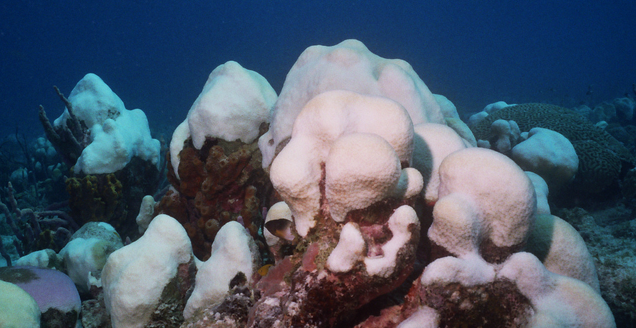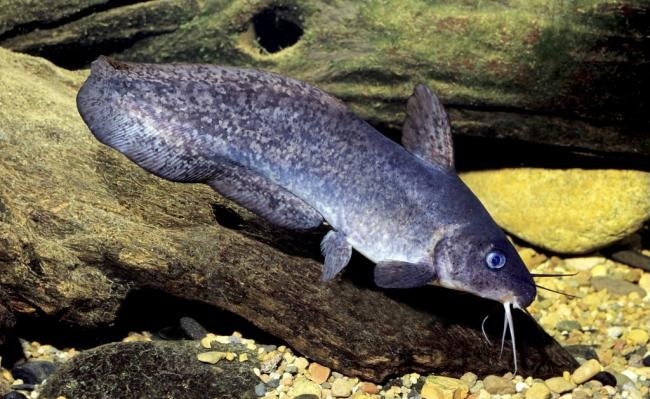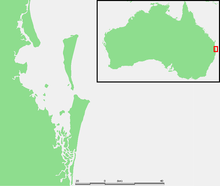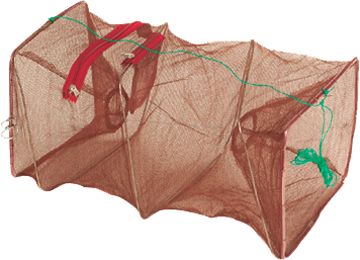The man whose job it should be to protect the Great Barrier Reef is actually afraid of water. The vast ocean, with all the creatures it contains, makes him uneasy. Only once has he visited the reef, the world's largest and most beautiful. Just thinking about the visit makes his skin crawl.
Andrew Powell, 40, the environment minister of the Australian state of Queensland, is a stocky man with a boyish face. Sitting in the neon-lit cafeteria of the parliament building in the state capital Brisbane, he smiles at the memory of his ill-fated expedition to the reef. "I get seasick very quickly," Powell explains, "and I don't do sharks very well."As he was snorkeling over the reef, he says, a reef shark swam directly beneath him. The horrifying animal was at least twice as big as he is, Powell insists. "My wife says it wasn't more than a meter long," he admits, "but it was enough for me." He swam back to the boat and refused to go back into the water.

The reef is a place of vast biodiversity and is home to a quarter of all species that exist in the world's oceans. DPA
The 2,300-kilometer (1,430-mile) Great Barrier Reef, off the coast of Queensland in northeastern Australia, is a natural wonder. It is home to a quarter of all species that exist in the world's oceans. In 1981, it became the first ocean region to be declared a UNESCO World Heritage site.
But now UNESCO is threatening to add the Great Barrier Reef to its list of protected sites that are "in danger." The authors of a report presented to the World Heritage Committee in June are "extremely concerned" about the condition of the reef. UNESCO wants the Australian government to demonstrate that it is serious about saving the reef, or else it will be officially classified in 2014.
'Five Minutes to Midnight'
"When a place is recognized as a World Heritage site," says Fanny Douvere, the lead author of the report, "it is both a recognition and a responsibility." UNESCO, she adds, is essentially saying to Australia: "Look, it's five minutes to midnight."
She is far from the only one concerned. Australian scientists have calculated that the Great Barrier Reef, the earth's largest living organism, has lost half of its coral in the last 27 years, and coral death is only accelerating.
One reason is that Australia feels the effects of climate change earlier and more strongly than elsewhere. Not only do rising water temperatures lead to coral bleaching in the summer, but increased levels of carbon dioxide in the atmosphere also raise ocean acidity, which damages the coral.
But storms and floods also flush mud, pesticides and fertilizers from farmland into the ocean, creating conditions under which a type of starfish that eats coral can thrive. And without healthy coral, fish, crabs, mollusks, sea turtles, manatees, dolphins, skates and sharks also disappear.
Man is also threatening the reef in a very direct way. Australia has the world's largest reserves of uranium, zinc and lead. It also has rich deposits of bauxite, iron ore, copper, gold, manganese and nickel, and no other country in the world has exported as much coal in recent years.
Mining companies have dug enormous open-pit mines in the country's interior, creating moonscapes covering a total of hundreds of square kilometers. Analysts also expect that in a few years Australia will produce more natural gas than Qatar, currently the world's largest exporter. Much of Australia's coal and natural gas reserves are in Queensland.
Coal from Australia, most of which is burned in Asia, is fueling climate change, which in turn is detrimental to the reefs. International energy companies are investing many billions of dollars in new mega-mines and infrastructure projects.
To double its coal exports, Australia is deepening and expanding ports, or building new ones, even in previously untouched protected areas. The silt from excavation is dumped into the ocean, polluting the reef.

Plans call for several ports near the reef to be built or expanded in the coming years, with ship traffic through the reef expected to double in the next few years. The dangers posed to the reef by tankers were highlighted in 2010 when this Chinese-registered coal tanker ran aground. DPA
'We Are in the Coal Business'
If all goes according to plan, twice as many freighters could soon be passing through the World Heritage site than do so today. And with increased traffic comes an increased risk of accidents such as the one three years ago which saw a Chinese freighter crash into the reef.
UNESCO is particularly alarmed about the plans of mine operators, which have also sparked growing resistance among scientists and environmentalists. The environment organization Greenpeace is collecting signatures to support a campaign of "civil disobedience to stop coal exports from Australia." In April, activists occupied a ship loaded with coal bound for South Korea.
"We are in the coal business," Queensland Prime Minister Campbell Newman said in response to UNESCO criticism. "If you want decent hospitals, schools and police on the beat, we all need to understand that."

The reef's designation as a UNESCO site is up for review, with the organization threatening to place the reef on its "in danger" list if Australia does not agree to a series of measures to ensure that degradation of the reef stops. Such a designation would be an embarrassment for Australia. Getty Images
But if current trends continue, the unthinkable could happen: the Great Barrier Reef could die.
The reef looks endless when seen from the vantage point of a helicopter. The ocean shimmers in every shade of blue, turning clear and turquoise-colored where the coral grows. Clouds cast dramatic shadows onto the water.
Of course the reef is near and dear to him, says Environment Minister Powell. "We wouldn't be Queensland without the Great Barrier Reef at our doorstep." The reef generates close to €5 billion ($6.5 billion) a year for the local tourism industry.
Powell has five children, he says. The youngest is three and the eldest 10, "and I want to leave them the Great Barrier Reef in better condition than it's in today." But the real question is what will remain of the Great Barrier Reef when Powell's children are adults.
"Our government was voted into office with the mandate to stimulate the economy," says the environment minister. "That's why we support the mining industry, construction and agriculture, as well as tourism."
And the reef?
Role Model Australia?
In keeping with UNESCO's wishes, Queensland is currently working on a strategy to develop its coastline in an environmentally sustainable way, says Powell. The national government in Canberra, he adds, is also developing plans for a marine park off the coast. The government expects to complete the overall concept to save the reef and present it to UNESCO by 2015, Powell explains.
Canberra will invest $200 million in the next five years to reduce pollution from agriculture and fight the coral-eating starfish. Queensland is contributing $35 million a year to the effort.
"I believe that we are doing everything we can to satisfy UNESCO's expectations," says Powell, leaning back in his chair. "Look, if Australia doesn't manage to have a healthy economy and simultaneously protect something as special as the Great Barrier Reef, who will?"
In this respect, Powell is right. Most tropical coral reefs are off the coasts of developing nations, whereas Australia is a prosperous country. In addition, climate change is not some abstract idea; the country has been suffering from the painful effects of global warming for some time. In other words, the Australians are in an ideal position to serve as role models.
"It would be a total embarrassment for us if the reef were placed on the list of World Heritage sites in danger," says Larissa Waters, 36. She isn't buying the environment minister's arguments. In her opinion, the government is being coopted by the extractive industry and isn't taking UNESCO's warnings seriously.

There are many in Australia who are trying to stop the degradation of the reef, including Larissa Waters. She is the first, and thus far only, member of the Green Party to be voted into the traditionally conservative Queensland Legislative Assembly. "UNESCO has concrete concerns that are simply being ignored," says Waters. "First, no ports in untouched regions; second, no port expansions that could impair the value of the reef; and third, a moratorium on port projects until 2015." Harrison Saragossi/ DER SPIEGEL

Waters is also a politician, though in a somewhat lonely position. She is the first and only member of the Green Party to be voted into the traditionally conservative Queensland Legislative Assembly. In office since 2010, she says that she hardly has any time left these days for issues other than the reef."UNESCO has concrete concerns that are simply being ignored," says Waters. "First, no ports in untouched regions; second, no port expansions that could impair the universal value of the reef; and third, a moratorium on port projects until 2015."
Her goal is to convince the state parliament to write UNESCO's recommendations into law. It's a futile struggle, and yet Waters remains optimistic. "I refuse to accept the idea that we will lose the reef," she says. "Australians have enough imagination and courage to prevent that from happening."
On a May afternoon, several hundred members of the Mining & Energy Services Council of Australia, an interest group representing the mining industry, meet at a golf club in the upscale Brisbane suburb of St. Lucia. Except for a few employees handing out name cards, the room is almost entirely filled with men.
They have come to listen to a speech by Paul Mulder, managing director for coal and infrastructure with the Australian-Indian energy giant GVK Hancock Coal. Mulder is there to present his current project: three new coal mines in Queensland's undeveloped Galilee Basin, together with a 500-kilometer rail line to the coast and a dedicated coal terminal.
While Mulder rattles off the superlatives of his project at the podium, a storm is brewing outside. Birds screech, and the wind howls through the windows, shaking the screens next to the podium. But Mulder, who is not tall but broad-shouldered, remains undaunted as he gets to the real subject of his presentation: The environmental activists who, as he claims, are damaging Australia's economy.
"I see a bunch of these activists jumping up and down, saying that we are destroying the reef," says Mulder. "They have no idea what they're talking about." According to Mulder, storms, starfish and coral bleaching are the reasons the reef is suffering. His coal has nothing to do with it, he says.
Besides, Mulder notes, coal is indispensable, providing 80 percent of electricity in Australia and China, 57 percent in India and 42 percent worldwide. "What sort of a society would we have without electricity?" Mulder asks. He says it is unfair of the anti-coal activists to deprive the "poor people in the Third World" of the kind of comfortable life they themselves enjoy.
Those who would obstruct the coal industry, according to Mulder's logic, are merely granting other resource-rich countries a competitive advantage, thereby weakening the Australian economy. As such, he explains, it is necessary for the government to eliminate bureaucratic hurdles and simplify approval procedures. The men in the room nod in agreement.
No Regulation, No Taxes
Mulder's words offer an insight into the mindset of his boss, the richest person in Australia and, depending on what happens to commodity prices, perhaps in the entire world soon -- a woman who wants people to see things her way. Gina Rinehart, 59, heir to the Hancock Prospecting mining empire, is worth about €23 billion. Rinehart doesn't speak with journalists but does pay some of their salaries. In addition to coal mining, she is also a major shareholder in Australia's leading media company, Fairfax Media Limited. And she is on the board of a television network group.
Her vision is a radical one: She wants an Australia in which the interests of the extractive industry are paramount, a place with little regulation, no taxes on natural resources or CO2, but massive numbers of low-wage guest workers from Asia, so that planned mega-projects can be implemented as quickly as possible. Rinehart uses her money and influence to make the voices of climate change deniers heard, and she has developed a following of like-minded billionaires and politicians. One of her fans is opposition leader Tony Abbott, who polls suggest could win the September election to become the next prime minister.
Abbott, the leader of the center-right Liberal Party, has characterized scientific conclusions about climate change as "absolute crap" and he successfully fought a planned special tax for the mining industry. Abbott has said that if he wins the election he will immediately abolish the CO2 tax introduced last year.
Wayne Swan, finance minister in the current Labor government, has called Rinehart and those who are like-minded a threat to democracy.
Is the Great Barrier Reef the price Australia will have to pay if Rinehart's worldview prevails?
Do Not Feed the Animals
Visitors to the natural wonder must first travel to Cairns, 1,350 kilometers north of Brisbane. The city's downtown area is filled with restaurants, souvenir shops and travel agencies. There are various ways to reach the reef: by sea, on multi-deck ships or sailboats, or by air, with small planes or helicopters that take passengers to islands or floating platforms above the reef. Once there, visitors can dive, snorkel or walk along the sea floor wearing a device that looks like an astronaut's helmet. There are warnings everywhere, admonishing visitors not to step on coral, feed animals, litter, use soap or urinate into the water.
Pale staghorn coral towers above the sea floor like a forest of bones, interspersed with sponge-like stony corals, large chunks of centuries-old coral and fat sea cucumbers resting on sandy spots. Schools of blue-and-white, yellow and striped fish swim past, and occasionally a larger fish peeps out from the forest of coral.
Russell Reichelt, 59, is paid to ensure that everything remains as it is. Head of the Great Barrier Reef Marine Park Authority, he has been tasked with investigating the impact of the natural resource boom. Reichelt is sitting in his office, with a view of the marina in Townsville, 300 kilometers south of Cairns. He looks at a map of the coast and says: "There's that old saying: death by a thousand cuts." He is referring to the deleterious effects of construction and pollution on the reef.
What Australia needs, says Reichelt, is a consensus that there is a breaking point for the reef that cannot be exceeded. "In my view, UNESCO's interest is welcome," says the reef administrator, "especially in this time of growing pressure."

The reef is also suffering from human activity in other ways. Storms and floods flush mud, pesticides and fertilizers from farmland into the ocean, creating conditions under which the crown-of-thorns starfish can thrive. The starfish spend most of their lives eating coral and have decimated parts of the Great Barrier Reef. dapd/ AIMS/ Katharina Fabricius
For the time being, his staff is focused on fighting the invasion of coral-eating crown-of-thorns starfish. The animals hide during the day, and at night they extrude their stomachs over the corals and digest them. To kill the starfish, divers inject multiple doses of sodium bisulfate into the middle of their bodies. Hundreds of thousands, possibly millions, of the coral-eaters populate the reef, making the divers' work a Sisyphean task. But at least it represents something the conservationists can do to protect the reefs.

The Great Barrier Reef remains a vital source of income for Australia, generating over six billion tourist dollars each year. DPA
Drinking Binges and Brawls
The heart of the coal industry can be found between Townsville and Brisbane. The town of Gladstone consists of a port stretching for 30 kilometers along the coast, surrounded by power plants, coalfields, scrap heaps and flat-roofed buildings. The air is filled with the roar of machinery. Workers fly in and out of Gladstone, where the local paper reports on nightly drinking binges and brawls.
Jan Arens, 56, also works for the coal industry, as an engineer for a company that produces wastewater treatment chemicals. He can't stop thinking about the activities he has witnessed in his job. He claims that the industry dumps toxic substances into the ocean and ignores regulations. "We have laws to protect the environment, but we bend and break them wherever we can," says Arens, a big-boned man with the coarse hands of laborer. "I'm not against the industry, but I am against such dishonesty."
Two years ago, Arens founded the city's only environmental protection organization, the Gladstone Conservation Council. The group has about 50 members, he says. They distribute flyers and take out ads in the paper. But the response has been modest. "I want my children to be able to say one day that at least their old man tried to do something," says Arens.
Energy companies are currently investing $33 billion in new coal and gas projects around the port of Gladstone alone. The projects are scheduled for completion in 2015, which will coincide with the Australian's government's completion of its plan to save the reef.
Translated from the German by Christopher Sultan

















